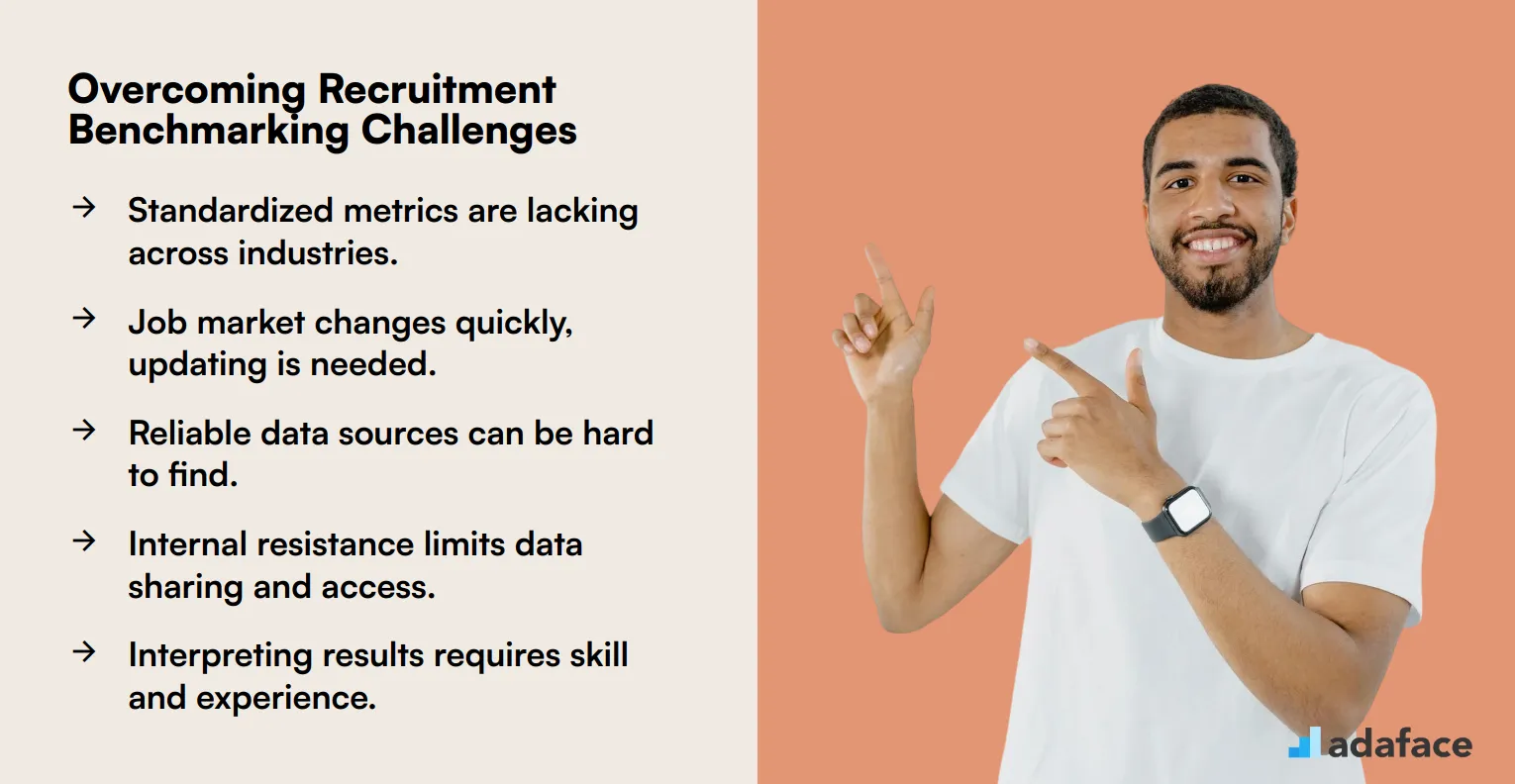Market benchmarking in recruitment is like checking the prices of items before you shop. It helps you understand current compensation, time to fill, and other metrics in your industry, ensuring your recruitment strategies are competitive.
By understanding industry standards, you can optimize your recruitment process, attract top talent, and reduce the cost of a bad hire. Benchmarking provides insights that drive informed decisions and improve overall hiring effectiveness.
Table of contents
What is market benchmarking?
Market benchmarking is a process used by organizations to compare their practices and performance metrics against industry standards or competitors. This allows companies to identify areas for improvement and understand how they stack up in the market.
In recruitment and HR, market benchmarking involves analyzing salary ranges, benefits, and other employment practices to ensure competitiveness in attracting and retaining talent. It helps businesses align their recruitment strategies with industry trends and expectations.
By engaging in market benchmarking, companies can make informed decisions about compensation packages and talent acquisition. This ensures they remain attractive to potential employees while maintaining budgetary constraints.
Understanding the market landscape is crucial for HR professionals to develop effective recruitment strategies. It provides insights into what competitors are offering, allowing for adjustments that can enhance the overall hiring process.
Ultimately, market benchmarking is a valuable tool for recruitment teams to ensure their practices are aligned with industry standards. It fosters a competitive edge in the talent market, which is essential for long-term organizational success.
Why is market benchmarking important for recruitment?
Market benchmarking is a game-changer for recruitment because it helps recruiters and hiring managers understand the competitive landscape. By comparing your organization's practices with industry standards, you can identify areas for improvement and enhance candidate experience.
It allows you to set realistic salary expectations, ensuring that your offers are attractive yet sustainable. This knowledge helps in attracting top talent who might otherwise be drawn to competitors offering better packages.
Benchmarking provides insights into the effectiveness of your recruitment strategies, enabling you to refine them for better outcomes. This can be crucial in reducing time-to-hire and improving the overall quality of hires.
By understanding market trends, you can anticipate future hiring needs and align your recruitment efforts accordingly. This proactive approach can be a significant advantage in a rapidly changing job market.
Incorporating market benchmarking into your recruitment process not only boosts your organization's appeal but also strengthens your position in the talent market. It empowers you to make data-driven decisions that align with your business goals.
Key metrics for recruitment benchmarking
Recruitment benchmarking is the process of comparing your hiring practices against industry standards to identify areas for improvement. Key metrics for recruitment benchmarking help interviewers understand how their processes stack up against others in the field.
Time to Fill is a metric that measures the number of days it takes to fill a position from the moment a job requisition is opened until an offer is accepted. A shorter time to fill often indicates a more efficient recruitment process, which can be achieved by using effective recruitment strategies.
Cost per Hire calculates the total expenses associated with hiring a new employee, including advertising, recruitment agency fees, and onboarding costs. Keeping this metric low while maintaining quality can be challenging, but it is crucial for budget management.
Quality of Hire assesses the performance and productivity of new employees, typically during the first year of employment. This metric helps determine the effectiveness of your selection process and whether the candidates hired are meeting job expectations.
Candidate Experience reflects how job applicants perceive your hiring process, from initial contact to final decision. A positive candidate experience can enhance your employer brand and attract top talent, as highlighted in candidate experience surveys.
Offer Acceptance Rate indicates the percentage of job offers accepted by candidates. A high offer acceptance rate suggests that your job offers are competitive and appealing to candidates, which is essential for successful recruitment.
How to conduct market benchmarking for recruitment
Conducting market benchmarking for recruitment involves comparing your hiring practices against industry standards to ensure competitiveness. This process helps recruiters and hiring managers understand where they stand in terms of salary, benefits, and other employment conditions compared to similar organizations.
Start by identifying key metrics to measure, such as time-to-hire, cost-per-hire, and quality-of-hire. These metrics provide a baseline to evaluate your recruitment process and identify areas for improvement.
Gather data from various sources, including industry reports, salary surveys, and recruitment analytics. This data will help you understand current trends and set realistic benchmarks for your organization.
Analyze the data to identify gaps between your current practices and industry standards. This analysis will guide you in making informed decisions to enhance your recruitment strategy.
Finally, implement changes based on your findings and monitor the results. Continuous evaluation and adjustment will ensure your recruitment practices remain competitive in the ever-evolving job market.
Tools for market benchmarking in HR
Market benchmarking tools in HR are designed to help recruiters and hiring managers evaluate and compare their recruitment strategies against industry standards. These tools provide insights into salary ranges, skill demands, and hiring trends, ensuring that your recruitment processes remain competitive and effective.
One popular tool for market benchmarking is salary benchmarking software, which allows HR professionals to compare their company's compensation packages with those of other companies in the same industry or region. This helps in making informed decisions about salary offers and adjustments, ensuring that they attract and retain top talent.
Another useful tool is recruitment analytics platforms. These platforms analyze various recruitment metrics, such as time-to-hire and quality-of-hire, to identify areas for improvement and optimize the recruitment process. By utilizing these insights, HR teams can streamline their efforts and enhance their overall recruitment strategies.
Competency management systems are also valuable for market benchmarking. These systems help in mapping the skills and competencies required for different roles and comparing them with industry benchmarks. This ensures that the organization is aligned with market expectations and can effectively address any skills gaps.
In addition to these tools, HR professionals can benefit from talent mapping solutions. These solutions provide a comprehensive view of the talent landscape, helping organizations identify potential candidates and understand the availability of skills in the market. This information is crucial for planning future recruitment drives and aligning with business objectives.
Common challenges in recruitment benchmarking
Recruitment benchmarking can be challenging due to several common obstacles. One major hurdle is the lack of standardized metrics across industries, making it difficult to compare data accurately.
Another challenge is the rapidly changing job market, which can quickly render benchmarks obsolete. This constant flux requires frequent updates to benchmarking data to maintain relevance.
Access to reliable and comprehensive data sources can also be a significant roadblock. Many organizations struggle to find accurate benchmarking information that aligns with their specific needs and industry.
Internal resistance to sharing sensitive recruitment data can hinder effective benchmarking efforts. Some companies may be hesitant to disclose their recruitment metrics, limiting the pool of available comparative data.
Lastly, interpreting and applying benchmarking results effectively can be challenging. Translating data into actionable insights requires skill and experience, which not all recruitment teams may possess.

Conclusion
Market benchmarking is a powerful tool for recruitment and HR professionals. It helps organizations stay competitive, make data-driven decisions, and improve their hiring processes.
By understanding key metrics and overcoming common challenges, you can effectively implement benchmarking in your recruitment strategy. Regular benchmarking allows you to adapt to market changes and attract top talent.
Remember, benchmarking is an ongoing process, not a one-time event. Stay curious, keep learning, and use the insights gained to continuously refine your recruitment practices.
Market Benchmarking FAQs
Benchmarking helps you understand industry standards, improve your recruitment process, attract top talent, and make data-driven decisions. It also helps identify areas for improvement and optimize resource allocation.
Ideally, recruitment benchmarking should be conducted at least annually, or more frequently if there are significant changes in the market. This ensures your strategies remain competitive and aligned with current trends.
Common data points include time to fill, cost per hire, employee turnover rates, source of hire, and candidate satisfaction scores. Compensation data is also a key component.
Data accuracy, availability, and comparability can be challenges. Ensuring data is representative of your specific industry and company size is also important. Overcoming these hurdles allows for more reliable insights.
By understanding what candidates value, you can tailor your employer value proposition to attract top talent. Benchmarking helps you identify areas where your employer brand can be strengthened to stand out from competitors.
Skills assessments help you evaluate candidate proficiency against industry standards. This data can be benchmarked to ensure you're attracting and hiring talent with the right skill sets, while also understanding the current skills gap.

40 min skill tests.
No trick questions.
Accurate shortlisting.
We make it easy for you to find the best candidates in your pipeline with a 40 min skills test.
Try for freeRelated terms



